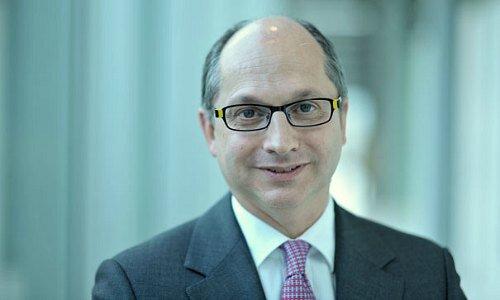UBS' next CEO, Ralph Hamers, faces a tough job in a hidebound culture. The move reunites him with a once-close ING ally who was key to the Dutch bank's digital shift.
Ralph Hamers is widely expected to make a change or two to UBS' management when he takes over as CEO of the Swiss wealth manager in November. The Dutch banker propelled ING, mainly a retail lender, into a far more digitally adept bank in seven years at its helm.
The 53-year-old executive was able to get ING into digital shape thanks to a leadership team around him which embodied and drove the bank's digital process. How Hamers plans to replicate this approach at UBS, where the average age in top management is 56, remains to be seen.
Digital Spearhead
He can count on at least one ally: Eli Leenaars (pictured below) is, like Hamers, Dutch. Leenaars joined UBS in 2015, from his last job at ING as head of challengers and growth countries, as a vice-chairman. Previously, he ran ING's international retail and direct banking business – but more importantly, he spearheaded its digitization.

Eli Leenars (Image: ING)
Leenaars has maintained a low profile in his five years in Zurich. His role is «senior relationship management with a focus on UBS' largest non-U.S. clientele,» according to his biography at Capital One, a major U.S. bank he is a board director of. The 59-year-old is also sometimes involved in projects at UBS as a consultant. He declined to speak to finews.asia.
Far more is known of Leenaars' 24-year career at ING: armed with a degree in law, he began as a client banker, eventually advancing to country and regional boss for ING in the U.S. and Latin America. In 2004, he made it into top management, where he was tasked with retail and private banking, but also ING's operations and IT.
Textbook «Agile» Overhaul
Crucially, Leenaars was instrumental in the post-crisis transformation of ING. Initiated by CEO Jan Hommen in 2009, Hamers later overhauled the banking group's axing infrastructure in favor of a so-called agile organization.
The new workplace methods were aimed at stepping up ING's digital-savvy in order to keep pace with client needs. The bank's Hamers-led shift is frequently cited as a textbook example for students at Harvard Business School, and even McKinsey is a fan.
Cramming at IMD
As head of ING's retail banking arm at the time, Leenaars was one of the principals in the transformation. Somewhat daunted by the job, he headed for Lausanne's IMD to beef up in order to have the skills and credibility to lead the process.
The elite business school customized a program for Leenaars aimed at equipping him with the tools to lead a fundamental shift at ING. With the help of coaches and lecturers, he crammed the curriculum into three weeks before returning to ING's Amsterdam offices to get to work.
Brussels Deal
Following the financial crisis of 2008/09, Leenaars developed a reputation as an excellent listener and negotiator: he hammered out the conditions in Brussels for ING's restructuring plan following its Dutch government bailout in 2008.
In Switzerland, Leenaars is better known as an expert on the future of digital banking. At UBS, however, he hasn't led any digital projects himself, though he has advised. It isn't clear whether Leenaars will be called back to active duty when Hamers joins in six months.
Outmaneuvered at ING
When Hamers won the CEO job at ING in 2013, Dutch media reported Leenaars was outmaneuvered by the younger banker. Less than a year later, Leenaars quietly left ING. The two know each other well: as recently as 2011, Hamers would have reported to Leenaars as ING's head of network management for the retail unit run by the latter.
Just three years later, the tables had turned: as CEO Hamers was fulsome in his praise for the outgoing Leenaars' management of various businesses, financial crisis handling, and «pivotal role in the execution of ING's restructuring process».



















